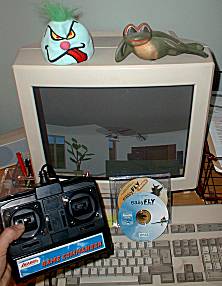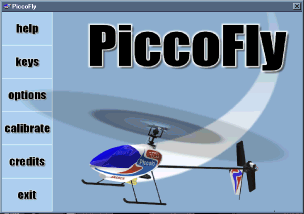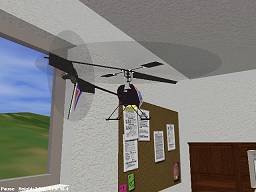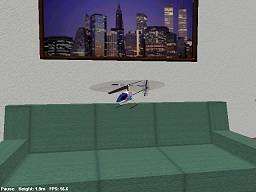Ikarus "Piccofly" Flight Sim
Good Morning, Commander!
 The Piccofly is a dedicated simulator for the Piccolo electric heli. It comes in two versions, one with its "Game Commander", and another which allows you to use your own transmitter via a serial port.
The Piccofly is a dedicated simulator for the Piccolo electric heli. It comes in two versions, one with its "Game Commander", and another which allows you to use your own transmitter via a serial port.
The Game Commander does not require batteries, is lightweight, and avoids any problems with compatibility with different makes of R/C. Stick feel is very good for a cheap controller.
Since I fly mode 2, I had to move the throttle ratchet from the right to the left stick. It means taking undoing four screws, removing the back of the case, and fiddling with springs and ratchets.
Software Installation
Software is supplied on CD and installation is straightforward. All the files including one DLL are copied to a single directory. DirectX 7 drivers are also installed.
Get the Right Graphics Card
Whatever graphics card you use, it must have drivers which support Open GL. My set-up consisted of a Pentium II 450 with an old Matrox Millennium G200 graphics card. I managed get up to around 20 frames per second max, at 16-bit colour and 640*480. With the model flying close up the frame rate is reduced. But it is generally perfectly usable which is good news for those with old-ish systems.
With a proper 3D card it would of be a lot smoother and higher resolutions could be used up to 1024 x 768.
Calibrate, then Levitate!

You first have to calibrate the Game Commander via a dedicated screen. Then click on the Piccolo graphic and away you go...
The action takes place in a suburban house in heliville - well that's my name for it! Several scenes are provided, e.g. lounge, kitchen, office, roof garden and basement. They all are part of the same 3-D model so you can explore the house by flying through doorways. You can even go outside through the back door, whereupon the sim allows you to explore the hills round the house and even go for a trip over the sea.
Rendering are fairly "blocky" by todays standards. However, collision detection works flawlessly - any object which is displayed can be hit or landed on - including the sink taps in the kitchen, although I think I'd get the model wet before succeeding with this one. After a crash, the re-start does not always take place from the original viewpoint - the solution is to press F4 once for each scene, then all is well thereafter.Several viewpoints are available - fixed standpoint, or attached to model, plus variations on each. To explore the house you have to follow the model, but this is tricky as there is no static reference point. I've managed to fly into three rooms from the living room. Getting back in one piece is a challenge, as is flying down stairs!
The Simulation


Actual screen shots
It took me about 1/2 hour to get into simulation mind-set, visual cues for height and depth in particular need getting used to, and you need to get to know the layout of the rooms.
However once you get over that the simulation is surprisingly realistic in terms of the model response. For example:
- Motor torque effects are well simulated. You can slither the model across the floor like the real thing.
- Once in the air, you can get into the dreaded PIO ("pilot induced oscillation") just like the model, where the Piccolo goes backwards and forwards in pendulum fashion. Initially I found this oscillation difficult to control however, about a while I was controlling this automatically, by juggling the throttle against the pitch control. The sim is really useful for this kind of thing.
- Tail rotor control is another hurdle for a new chopper pilot, the sim is an excellent way to practice this.
If I have any niggles, it's that the simulation is perhaps a bit too smooth and would benefit from a little random turbulence.
Stick sensitivity is not configurable out of the box, however a patch from the Ipacs site allows this, and also allows the "clock tick" to be altered for those with the reflexes of an elephant! I would like to be able to alter the mixing and gyro sensitivity. Sound Tip! If you don't like the crash sound, replace crash.wav in ...\ipacs\piccofly\sound directory with a suitable alternative.Updates and Technical Support
The Ipacs site contains patches as well as a user forum.
I rang Ikarus to ask about compatibility with my graphics card, and the technical support was quick and courteous.
Conclusion
Did it improve my flying? Yes, definitely! After weeks a lot of crashing and fixing the Piccolo, I spent about four hours total on the sim. I then flew the model in the living room and managed a flight of 75 seconds under more or less full control without hitting anything. After a few more hours on the sim, I flew the Piccolo and managed several full-duration flights with the trainer gear removed.
It may not be the ultimate in terms of pure graphics, but the actual simulation is pretty good. If you are a rookie Piccolo pilot, I can definitely recommend the Piccofly to shorten your learning curve. Check on the suitability of your graphics card if you are using an old system.
